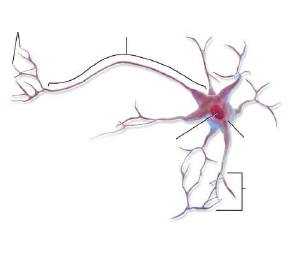Chapter 9 - The Nervous system
1/51
There's no tags or description
Looks like no tags are added yet.
Name | Mastery | Learn | Test | Matching | Spaced |
|---|
No study sessions yet.
52 Terms
What are the main components of the nervous system?
Brain
Spinal cord
Nerves extending from the spinal cord
What are the two subdivisions of the nervous system?
Central Nervous System (CNS)
Peripheral Nervous System (PNS)
What is the Central Nervous System (CNS) composed of?
Brain
Spinal cord
What is the Peripheral Nervous system (PNS) composed of?
Cranial and spinal nerves
Ganglia
Where is the brain located in the central nervous system?
Within the cranial cavity of the skull
Where is the spinal cord located in the central nervous system?
Within the vertebral cavity of the vertebral column
What does the peripheral nervous system consist of?
Nerve cells that extend from the brain and spinal cord
What are a cluster of nerve cells called in the nervous system?
Ganglia
The PNS and CNS overlapping functions 1 of 3
Sensory receptors that monitor changes inside and outside the body
The PNS and CNS overlapping functions 2 of 3
Processes and interprets sensory input
The PNS and CNS overlapping functions 3 of 3
Dictates a response by activating effector organs
What is a stimulus?
changes detected inside or outside the body
What is sensory input?
information gathered by receptors
What is motor output?
The response
Step 1: Sensory input - What does the Peripheral Nervous System (PNS) do?
Responsible for receiving/perceiving information about the enviornment around us (sensation) and generating responses to that information (motor response)
Step 1 Sensory input - The Peripheral nervous system can be subdivided into regions that are responsible for what?
Afferent division (Sensation)
Efferent division (Motor response)
Step 1: Sensory output - What is the first major function of the afferent nervous system?
Sensation
What is the role of sensation in the afferent nervous system?
Receives information about the environment to gain input about what is happening outside the body or within the body
Describe sensory stimuli
External stimulus picked up by one of the 5 main senses
Describe visceral stimuli
internal stimulus
What is homeostatis
Process of keeping your bodily process at normal, functioning levels
Step 2: Intergation
PNS afferent division sends signals about these external and visceral stimuli to the CNS which processes the information
Describe integration
Stimuli that are received by sensory structures are communicated to the nervous system where that information is processed
Step 3 - Response
After your brain integrates the information/stimulus it receives, it will then cause a response to occur
Step 3: Response - What are the two types of responses
Somatic system responses
The Autonomic system response
What is the somatic system response?
physical movement and/or voluntary actions based on the stimulus it received (running from a bear)
What is the Autonomic system response?
involuntary internal reactions to a stimulus (getting sleepy after eating a meal)
Which subdivision is the somatic nervous system a part of?
PSN Efferent (motor division)
What is the role of somatic nervous system (SNS)?
Responsible for conscious perception and voluntary motor responses
Describe voluntary motor reponses
means the contraction of voluntary skeletal muscle of the body (raising your hand to ask a question)
What subdivision is the Autonomic nervous system a part of?
PNS Efferent division
What is the role of Autonomic nervous system (ANS)?
Responsible for involuntary control of the body, usually for the sake of homeostasis
What is the role of autonomic systen>
Regulate the organ systems of the body, which usually means to control homeostasis
To help the body maintain homeostatis, the autonomic nervous system can be further subdivided into what two subdivisions?
Sympathetic division of the ANS
Parasympathetic division of the ANS
What is the role of Sympathetic division of the ANS
Stimulate the body's fight-flight-or-freeze response to potentially harmful situations
Sympatheic nervous system helps with what?
Increase heart rate
Increase breathing
Inhibit digestion
Increase blood glucose levels
What is the role of Parasympathetic division of the ANS
Responsible for stimulation of "rest-and-digest" or "feed and breed” activities that occur when the body is at rest, especially after eating, including sexual arousal, salivation, urination, digestion and defecation
Parasympatheic nervous system helps with what?
Decrease heart rate
Decrease breathing
Resume digestion
Decrease blood glucose levels
The nervous tissue contains what two basic types of cells
Neurons
Neuroglial cells
Match the photo to the neuron

What is the role of neurons
responsible for producing and receiving chemical and electrical signals
Match the photo to the neuroglial cell

What is the role of neuroglial cells
support cells that ensure neurons are safe and cared for
Describe chemical signaling
using neurotransmitters to communicate between neurons
Describe electrical signaling
using electricity to quickly send a message with in one neuron. Also called an action potential
What cells are considered to be the basis of nervous tissue
Neurons
What is the role of axons in the cell body
pathway for the electrical signals being sent from the main cell body to the end of the axon
What is the role of dendrities
allow the cell body of the neuron to make connections with many other neurons and receive signals
Describe an electrical impulse
the physical phenomena arising from the attraction of particles with opposite charges and the repulsion of particles with the same charge
When a neuron is at its resting state, it has high concentration of Na+ on the…
outside of the cell compared to inside
When a neuron is at its resting state, it has high concentration of K+ on the…
inside of the cell compared to outside